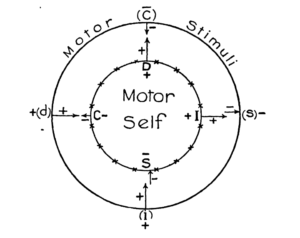


In this post, we will outline the background of the DISC assessment as a coaching assessment tool so that you can use it effectively to interpret the results of your respondents.
Note: The DISC assessment is included as part of your Evalinator subscription. You can try out a shortened version of the DISC assessment here.
DISC was first as outlined by it’s original creator, William Marston, who wrote a book titled Emotions of Normal People in 1928 and explained the DISC model in great detail. It is indeed a fascinating and deep subject.
Marston’s idea behind DISC was people have dynamic and fluid behavior types that came from 2 dimensions:
So, the 4 traits in DISC stand for the following:
So what does this mean?
These DISC behaviors have important connotations. And they are just the way people tend to react in certain situations.
Dominance consists of increasing of the self to overcome an antagonistic situation. The tendency is to remove or overcome opposition. It could be via active means or via passive resistance.
Some terms (taken from the book) to describe this behavior are: aggressiveness, fury, self-assertion, initiative, will, high spirit, self seeking, courage, dare-deviltry, purposiveness , persistency , force of character, stubbornness, instinct of self-preservation, superiority complex, ego-centricity.
Inducement consists of increasing of the self to induce or win the voluntary submission of the other party or parties in a generally favorable situation.
Some terms to describe this from are: persuasion, captivation, convincing, luring, magnetism, charm, winning someone’s confidence, leading a person.
Submission consists of a decrease of the self to an “allied” party to allow that allied party to be the driver of action or thought. This is typically the reaction someone respected gets from others. The interests are aligned, not forced upon the other party.
Various inexact terms applied to submission emotion may be as follows (taken from the book): willingness, docility, good nature, a good child, benevolence, being accommodating, obedience, admiration, being tractable, altruism.
Compliance consists of a decrease of the self to a party with authority in order to be in harmony with an external force, sometimes as a result of feeling of inevitability or something to be accepted without question for the greater good.
Some terms to describe this (taken from the book are): being afraid to do, caution, conforming, swimming with the stream, open mindedness, candor, being a realist, adapting, yielding to, doing God’s will, being well disciplined, bearing one’s burdens, humility, respect for the strength of the antagonist, tolerance.
Note that these 4 types have nothing to do with being friendly, talkative, analytical, or outgoing. Any of these traits can apply to any of the 4 DISC behaviors. And that’s why some commercial personality assessment models based on DISC have received so much flak. It all depends on the state of the environments and your tendency to increase or decrease the self. Someone could be a D at work in a certain situation, but behave as a C in another work situation.
DISC attempts to describe the emotions of normal people, and people are not normal when they are afraid, or enraged, or deceptive. Moreover your response to situations will be different. The following illustration taken from the book Emotions of Normal People will illustrate this.

Marston likened this to a color wheel that transitions between primary colors. William Marston outlined this salient example in his book. Upon running away from a bully, a boy’s mother demanded that he go back and face his adversary. The boy complied and it showed he “submitted” to or “aligned with” his mother as the benevolent party. He then faced his adversary (Dominance) and the bully backed away (showed compliance). So within a few minutes, the behavior dynamics changed.
Therefore, rather that thinking of our DISC styles as labels that define us, we should think of them as the way we respond to certain stimuli as our environment changes. Our belief systems also play an important role in it.
If you’re a coach, you can sign up to use the full DISC assessment for your own practice. Try out a shortened version for free here. The full version of our DISC assessment has more questions for a more comprehensive analysis, and also has profile segmentation fields for more in-depth coaching.
Other assessments included as part of your subscription are:
Each assessment also comes with goal setting included, and you can white label them on your own website!
Read more here about how the Evalinator platform offers various coaching tools that help you grow your practice.
Sign up now and take advantage of the free 14 day trial!

Feeling frustrated with lead generation?
Take this free, 5-minute quiz and get more prospects into your leads funnel.
Instant Results. Actionable recommendations. Email required.
Find Your Score >>